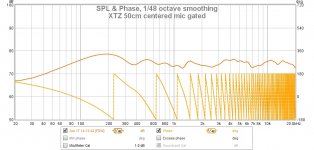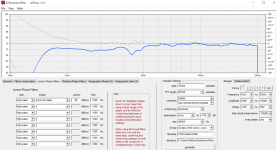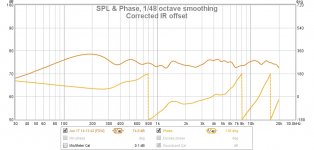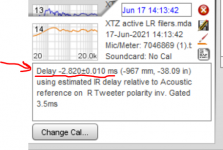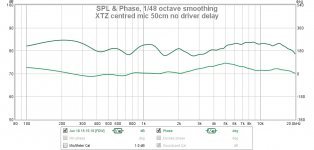All of the tutorials cover the mechanics of using rephase in various different ways. They tell you how to do something but they don't always tell you why.
Before you start trying to use the program you need to be clear what you intend to do with it and why. This thread has got long but there is a huge amount of the how and why here but unfortunately it is spread out and not so easy to find. I would strongly urge you to skim through it as much as you can from the start as it will be educational.
If you have enough taps then I think that there is good reason to go below 100Hz with corrections but making the right measurements and knowing how to interpret them to decide on what you should try and correct is not so simple. Corrections below 400Hz or so are likely to have the most useful impact as this is where the room is becoming a significant factor.
Whether you should measure the main speakers at the same time as the subs will depend on what you want to do with those measurements. Is it a mono bass managed system or are the left and right channels going to independent subs. Are you looking to make an overall correction to the stereo channels or are you looking to make changes to each driver somehow.
MMM are good for tonal balance but the phase information is lost. The technique of using a number of measurements and vector averaging will give an impulse to base phase corrections on but I have only found this to be a good technique in quite a reverberant room. Even then a single point measurement with the right analysis has given better results.
The ability to manipulate phase can be useful but it also gives a lot of scope to make things worse.
Before you start trying to use the program you need to be clear what you intend to do with it and why. This thread has got long but there is a huge amount of the how and why here but unfortunately it is spread out and not so easy to find. I would strongly urge you to skim through it as much as you can from the start as it will be educational.
To answer that it depends on what you have available to process the filter. To get good resolution at low frequencies requires a fairly large number of taps. Software convolution has no practical limit but hardware has quite severe limits. So first decide on whether it is practical to consider it based on your setup.Two questions I already have are:
1) It is unclear to me if one should produce FIR filters in the <100hz range (or just rely on PEQ filters). The reason I am asking, is to see if one should take measurements with the subwoofers playing, or just with the main speakers?
If you have enough taps then I think that there is good reason to go below 100Hz with corrections but making the right measurements and knowing how to interpret them to decide on what you should try and correct is not so simple. Corrections below 400Hz or so are likely to have the most useful impact as this is where the room is becoming a significant factor.
Whether you should measure the main speakers at the same time as the subs will depend on what you want to do with those measurements. Is it a mono bass managed system or are the left and right channels going to independent subs. Are you looking to make an overall correction to the stereo channels or are you looking to make changes to each driver somehow.
Generally you would want to process the Left and Right channels separately as it is unlikely that they have the same response. matching the levels and frequency response at the listening position can make quite a big difference to the sound on it's own. As depending on how symmetrical the room layout and furnishings are and distances to walls, will have a big impact on whether the speakers integrate well at the listening position. Both channels can measure well independently but can be a total mess when combined due to cancellations and interactions between the channels and wall boundaries.2) The measurements, combining/averaging of measurements, PEQ and FIR filters generated should all be done on the L and R speakers independently correct? As having the speakers the same listening distance to the MLP should result in good and adequate integration between the two speakers correct? Sorry for such a general question, I am used to using the MMM for L&R speakers and subs combined and then applying a global EQ, so I am just confirming that this process will occur on each channel independently.
MMM are good for tonal balance but the phase information is lost. The technique of using a number of measurements and vector averaging will give an impulse to base phase corrections on but I have only found this to be a good technique in quite a reverberant room. Even then a single point measurement with the right analysis has given better results.
The ability to manipulate phase can be useful but it also gives a lot of scope to make things worse.
Thanks for the info!
Hummm... wonder if there would be any utility in creating a 'live' google document that is based on prior tutorials and then everyone could contribute to it and edit it as they see fit. Then after a few months the document could be 'locked in' and updated on an as needed basis.
I had in the past little similar idea. All the knowledge is present in this thread, but it has 339 pages.
Generally also now is possible to share on Google drive document what can be edited by everyone who had Google account.
All of the tutorials cover the mechanics of using rephase in various different ways. They tell you how to do something but they don't always tell you why.
Before you start trying to use the program you need to be clear what you intend to do with it and why. This thread has got long but there is a huge amount of the how and why here but unfortunately it is spread out and not so easy to find. I would strongly urge you to skim through it as much as you can from the start as it will be educational.
Do you think there would be a desire for a communal tutorial document to try and consolidate some setup info?
To answer that it depends on what you have available to process the filter. To get good resolution at low frequencies requires a fairly large number of taps. Software convolution has no practical limit but hardware has quite severe limits. So first decide on whether it is practical to consider it based on your setup.
I believe that equalizer APO can act as a convolver so I was going to run my filters though EAPO on my laptop where I stream Tidal and Spotify.... so having increased latency would not bother me. Do you see any problems with this plan?
Whether you should measure the main speakers at the same time as the subs will depend on what you want to do with those measurements. Is it a mono bass managed system or are the left and right channels going to independent subs. Are you looking to make an overall correction to the stereo channels or are you looking to make changes to each driver somehow.
I stream from my laptop via HDMI to my receiver and then it looks after bass management for the speakers and subs. The subs get the mono output to my behringer amp where I set the delays for each sub independently. Then the behringer also does PEQ filters for a smooth bass response.
Generally you would want to process the Left and Right channels separately as it is unlikely that they have the same response. matching the levels and frequency response at the listening position can make quite a big difference to the sound on it's own...
Yeah my room is very symmetrical, but that totally makes sense. Thanks!
I don't know. What would be useful to anyone starting this journey is a document that explains methods of measurement, how to use them what to look for, what to leave alone etc. Perhaps a collection of links to the most useful discussions in this thread would be helpful to make it easier to find the good information that has become buried.Do you think there would be a desire for a communal tutorial document to try and consolidate some setup info?
Following tutorials without much understanding of why the process is being done leads to all the same questions being asked repeatedly.
EAPO will work to give you an overall stereo filter. This will be good for getting channel levels equal and setting the overall tonal balance. DRC_FIR is really good for that sort of in room balancing but the learning curve puts people off. Greg has some scripts and instructions here that I think makes it accessible to anyone willing to put in some effort.I believe that equalizer APO can act as a convolver so I was going to run my filters though EAPO on my laptop where I stream Tidal and Spotify.... so having increased latency would not bother me. Do you see any problems with this plan?
A convolution based alternative to electrical loudspeaker correction networks
For that I would look at andyc's multisub optimizer program, go through the tutorial there to get a good idea of how to go about it.I stream from my laptop via HDMI to my receiver and then it looks after bass management for the speakers and subs. The subs get the mono output to my behringer amp where I set the delays for each sub independently. Then the behringer also does PEQ filters for a smooth bass response.
Multiple Subwoofers: Optimize Them With Multi-Sub Optimizer Software
The filters are not linear phase, but their sum is.
The off axis behavior is different that a LR for sure: musicanddesign - Power
I spent a week digesting this article.....
I read it many times over and over.....
I can apply this to a car.... I’ll need help with the math , but this makes things....much more predictable... my goodness what a great read indeed thank you!
Biggest shortage of all tutorials is that they not contain explanations why some steps are done or needed.
Also I did not remember any tutorial is explaining how to use correctly rePhase Filter Linearization options.
Great tool but relatively long learning curve because lack of documentation when you start from zero.
Thank you for very much for valuable comments. Would you be willing work together on correction of " REW average measurements and impulse correction rePhase" tutorial ,please. We did wrote that tutorial to best of our ability at the time and goal was to write easy to understand and to follow manual. I do have a feeling ,that work will benefit much from your contribution.We can exchange e mail addresses and results will publish there and in rephase.org.
Last edited:
Member
Joined 2003
Ignoring electronic complexity, what are the acoustic pros and cons of two different approaches:
1. 3-way, different acoustic centers, standard passive crossover, with software correction of system phase.
vs.
2. Same 3-way, same (different) acoustic centers, software correction of individual driver arrival time, and phase.
1. 3-way, different acoustic centers, standard passive crossover, with software correction of system phase.
vs.
2. Same 3-way, same (different) acoustic centers, software correction of individual driver arrival time, and phase.
Ignoring electronic complexity, what are the acoustic pros and cons of two different approaches:
1. 3-way, different acoustic centers, standard passive crossover, with software correction of system phase.
vs.
2. Same 3-way, same (different) acoustic centers, software correction of individual driver arrival time, and phase.
Nice pages Paul, enjoyed your blog...and what a collection of speaker projects !!
What are the copper-colored tubey-looking things, in the lower cabinets on your home page? Looks like maybe funky radiators !
Here's my thoughts on the 2 paths, hopefully others will add on.
1. I think alot depends on how well the passive crossovers were implemented in matching phase traces between drivers, and in achieving good time alignment of the acoustic centers.
If good time alignment of acoustic centers hasn't been accomplished, any phase trace measurements are valid only for a single measurement distance.
Even if good time alignment has been achieved, if the phase traces don't lay on top of each other throughout the xover region, the measurement of their summation won't reflect either of them, but will reflect some kind of blend.
Their summation is not minimum phase, and correction begs legitimacy.
Whatever passive tuning has been achieved, the bottom line ime, is that correcting phase on top of it is likely effective only to a very specific spot.
The better the passive tuning, the higher the likelihood of a bigger spot.
Correcting phase here probably has the ironic capability of helping a bad speaker the most, if one's willing to lock their head in a vise, Lol
2. Software correction of phase at the driver level, the minimum phase level,
is well known to be valid. Add complementary linear phase xovers, and the only phase anomalies left are natural acoustic rolloffs. But even those can be offset by a combination of out-of-band min-phase magnitude flattening, and an equivalent amount of steepening added to the order of the linear phase xover being used.
When all that is done, time alignment becomes no more than adjusting for time of flight to mic, and hold up very well over wider areas (along with phase.
So really, there's no comparison in my mind between 1. and 2.
Others may see it differently
One last train of thought...
Pre-ringing is commonly brought up (usually by readers as opposed to doers
Can anybody comment this: Does Phase Distortion/Shift Matter in Audio? (no*) | Audio Science Review (ASR) Forum
I think phase is not so simple thing, some phase errors can be audible.
I think phase is not so simple thing, some phase errors can be audible.
Early stage venture into active FIR crossover
Hi all
I'm trying to learn this active FIR crossover stuff and was hoping I could ask for some advice. Today I took some measurements of drivers, imported those into rephase and did some amplitude EQ, phase EQ and set up some steep LR filters. After generating the IR I imported those back into REW to simulate the result. After some tweaking I loaded the IR files into EQAPO and remeasured speakers.
I was reasonably happy with the FR but the phase plot seems like a mess to me. Is there anything obvious I'm messing up here you think?
My setup :
Laptop running EQAPO, REW for measurments with UMIK-1 and rephase to design filters.
HDMI to 7.1 reciever Yamaha RX-V1700 feeding two XTZ 93.23 mkII with crossovers removed.
Hi all
I'm trying to learn this active FIR crossover stuff and was hoping I could ask for some advice. Today I took some measurements of drivers, imported those into rephase and did some amplitude EQ, phase EQ and set up some steep LR filters. After generating the IR I imported those back into REW to simulate the result. After some tweaking I loaded the IR files into EQAPO and remeasured speakers.
I was reasonably happy with the FR but the phase plot seems like a mess to me. Is there anything obvious I'm messing up here you think?
My setup :
Laptop running EQAPO, REW for measurments with UMIK-1 and rephase to design filters.
HDMI to 7.1 reciever Yamaha RX-V1700 feeding two XTZ 93.23 mkII with crossovers removed.
Attachments
Hi, phase looks pretty good really...certainly so in comparison to using minimum phase xovers.
And if you notice, the phase wobbles occur in coincidence with the frequency response wobbles.
Use the Paragraphic Gain EQ Tab to smooth out the frequency response, and watch how phase smooths itself out too.
And if you notice, the phase wobbles occur in coincidence with the frequency response wobbles.
Use the Paragraphic Gain EQ Tab to smooth out the frequency response, and watch how phase smooths itself out too.
Thanks for your response.
I guess you are mainly talking about the rephase picture with my filter settings? I have done what you suggest to some extent, but I don't concider myself done
I was mostly wondering about the REW measurement, where FR is reasonable smooth but phase seems to wrap endlessly - wich I don't understand why the measured phase do not resemble the phase plot in rephase, at least to some extent. I thought this was the effect of linear phase filters
My gut says I'm missing something pretty obvious here in regards to my measurement
I guess you are mainly talking about the rephase picture with my filter settings? I have done what you suggest to some extent, but I don't concider myself done
I was mostly wondering about the REW measurement, where FR is reasonable smooth but phase seems to wrap endlessly - wich I don't understand why the measured phase do not resemble the phase plot in rephase, at least to some extent. I thought this was the effect of linear phase filters
My gut says I'm missing something pretty obvious here in regards to my measurement
Last edited:
Gotcha.
In REW, it's just a matter of getting rid of the constant delay, time-of-flight, etc, from the measurement.
I use loopback timing to do this, which makes life easy.
Not exactly sure how Umik works.
But i'll suggest:
1. go to the Impulse tab, and click on 'Set t=0 at IR start'
2 go back to SPL & Phase and see how phase looks....should be much better, other than maybe VHF tail
3. still in SPL & Phase, open Controls, and click on 'Offset t=0'
4. move slider around a little till it matches rePhase, looks right, etc.
In REW, it's just a matter of getting rid of the constant delay, time-of-flight, etc, from the measurement.
I use loopback timing to do this, which makes life easy.
Not exactly sure how Umik works.
But i'll suggest:
1. go to the Impulse tab, and click on 'Set t=0 at IR start'
2 go back to SPL & Phase and see how phase looks....should be much better, other than maybe VHF tail
3. still in SPL & Phase, open Controls, and click on 'Offset t=0'
4. move slider around a little till it matches rePhase, looks right, etc.
By loopback you mean for timing reference of your measurements?
I also have a Behringer emc 8000 and a external soundcard but I havent gotten far enough to try it out yet. I thought the UMIK would suffice. I have been using acoustic timing reference though, and thought that would work about as well as loopback.
This is about as good I could get it. I took the delay data from measurement and added to offset, that put the peak of IR at t=0, but is this method of measurement not acurate? Or what I'm struggling to understand is why does this happen to the phase plot now, but I havent seen this in other measurements of drivers.
Thanks again
I also have a Behringer emc 8000 and a external soundcard but I havent gotten far enough to try it out yet. I thought the UMIK would suffice. I have been using acoustic timing reference though, and thought that would work about as well as loopback.
This is about as good I could get it. I took the delay data from measurement and added to offset, that put the peak of IR at t=0, but is this method of measurement not acurate? Or what I'm struggling to understand is why does this happen to the phase plot now, but I havent seen this in other measurements of drivers.
Thanks again
Attachments
I had a some other measurements after several tweaks in rephase, and I see all of the phase plots in REW resembles the plot in rephase, if I use the measured delay as offset. Only my last measurement (the one I posted) would turn out with phase wraps. Then it dawned on me - one thing I did was add delay on the tweeters in EQAPO to time align the drivers. I would guess this is what causes the mismatch of phase in rephase vs. REW plots
So I guess my next thoughts are; how do I go from here to tweak the phase of my whole system/speaker including delayed drivers? I'm not entirely sure how to go about this task since I have made one IR wav file for each driver. Do I make one correction file on top of these, or is it possible to implement the corrections to each individual files?
So I guess my next thoughts are; how do I go from here to tweak the phase of my whole system/speaker including delayed drivers? I'm not entirely sure how to go about this task since I have made one IR wav file for each driver. Do I make one correction file on top of these, or is it possible to implement the corrections to each individual files?
Last edited:
Against loopback timing, all that is needed to get phase right, is first measure with 0.0ms 'Timing offset'. Then, put whatever Delay is shown in that 0.0ms measurement tab into 'Timing offset' and remeasure. It's that simple, with loopback.
Again, don't know how Umik, or acoustic timing reference works.
REW can have a truly bewildering array of timing options.
What i do on a multiway (using loopback), is with mic in same position, find each drivers' delay vs loopback.
That tells you which driver, the one with the greatest delay vs loopback, is the one the other drivers need to be delayed to.
And for the other drivers, by how much each of them needs to delay to match the longest.
Put the delay of the longest driver into "Timing offset'.
And add into the processor, each of the drivers' delays that are needed to match to longest.
All should be well. If not, measure each passband with delays in place and balance accordingly.
(If done right, delays should be within samples of being correct. If not, boo-boo has been made somewhere.)
Just remember, delays have to be set relative to longest measured.
Again, don't know how Umik, or acoustic timing reference works.
REW can have a truly bewildering array of timing options.
What i do on a multiway (using loopback), is with mic in same position, find each drivers' delay vs loopback.
That tells you which driver, the one with the greatest delay vs loopback, is the one the other drivers need to be delayed to.
And for the other drivers, by how much each of them needs to delay to match the longest.
Put the delay of the longest driver into "Timing offset'.
And add into the processor, each of the drivers' delays that are needed to match to longest.
All should be well. If not, measure each passband with delays in place and balance accordingly.
(If done right, delays should be within samples of being correct. If not, boo-boo has been made somewhere.)
Just remember, delays have to be set relative to longest measured.
Did you notice the frequency of the graph goes from 1k to 20k and the gain in phase at the bottom is below the crossover point?Hi, phase looks pretty good really...certainly so in comparison to using minimum phase xovers.
The phase in this graph looks strange to me. There is still a hinge point at the crossover frequency but you are losing phase below it and gaining phase above when it is usually the other way around.This is about as good I could get it. I took the delay data from measurement and added to offset, that put the peak of IR at t=0, but is this method of measurement not acurate? Or what I'm struggling to understand is why does this happen to the phase plot now, but I havent seen this in other measurements of drivers.
The main areas of excess phase from a speaker will come from minimum phase crossovers. If you make them linear and complementary then pretty much all of the excess phase should be gone. It should be quite close to the calculated minimum phase once you remove the time of flight delay like you have now and there should be no real need for the paragraphic phase EQ.
I wonder if perhaps your acoustic crossover slopes don't match your electrical slopes. If the drivers are equalized flat for a little distance either side before the 96 dB crossover is added then they should end up being the same.
In a properly constructed active speaker the time delays can compensate for most of the drivers distance offset and the EQ and crossover components should result in speaker that does not really need much more tuning than it already has as the overall slope and tonal balance can be set in.
Trying to correct a passive speaker can be more difficult as without delay to the separate channels, phase manipulation becomes necessary to try and achieve the same thing.
The phase in this graph looks strange to me. There is still a hinge point at the crossover frequency
I think this was because I kept lowering the XO point on the tweeter filter and entered into where my protection cap starts to work. If I understand correctly what you say about minimum phase filters this would do weird things to my phase. I also tried reversing tweeter polarity because there was a consistent big dip at XO point. This resulted in ok summation in FR but then phase got a lot worse. Add to that the delay on the tweeter I was messing with in EQAPO, I'm sure I just made a mess of several things.
Sorry for needing to be spoon-fed, but I'm not sure what the complementary thing means in rephase.The main areas of excess phase from a speaker will come from minimum phase crossovers. If you make them linear and complementary then pretty much all of the excess phase should be gone.
I tried this and still was having a hard time until I just deactivated the delay on the tweeter. Result was much better - see attached measurement. This is as far as I got before family duties called.I wonder if perhaps your acoustic crossover slopes don't match your electrical slopes. If the drivers are equalized flat for a little distance either side before the 96 dB crossover is added then they should end up being the same.
As per now this is presicely what I feel happened, only oppositeIn a properly constructed active speaker the time delays can compensate for most of the drivers distance offset and the EQ and crossover components should result in speaker that does not really need much more tuning than it already has as the overall slope and tonal balance can be set in.
Attachments
Did you notice the frequency of the graph goes from 1k to 20k and the gain in phase at the bottom is below the crossover point?
Nope, i was blind as a bat ! thx
- Home
- Design & Build
- Software Tools
- rePhase, a loudspeaker phase linearization, EQ and FIR filtering tool
